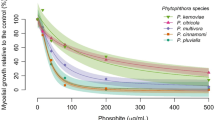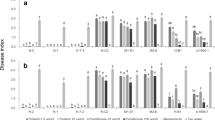Abstract
Fifty-eight isolates of Phytophthora infestans were evaluated in vitro and on detached leaves of potato for their sensitivities to metalaxyl-M and cymoxanil. The isolates belonged to the clonal lineage, EC-1, which is dominant on potato in Peru and Ecuador. All isolates were collected in Huánuco, Peru, an area of year-round potato production, where the potential for development of fungicide resistance is high. All isolates were resistant to metalaxyl-M, with in vitro EC50 values ranging from 468.30—813.57 mg l−1. In contrast, we found no evidence for resistance to cymoxanil for which in vitro EC50 values ranged from 0.03—1.11 mg l−1. Resistance to each fungicide was also evaluated for five isolates in a detached leaf assay in which the fungicide was sprayed on the leaf surface prior to inoculation. With metalaxyl-M, the range of EC50 values was 158.85—828.29 mg l−1, similar to that for the in vitro assay. For cymoxanil, EC50 values ranged from 1.41 to 2.31 mg l−1, which was higher than in the in vitro assay but still two orders of magnitude lower than the concentration applied by farmers in the field.



Similar content being viewed by others
References
Adler, N. E., Erselius, L. J., Chacón, M. G., Flier, W. G., Ordoñez, M. E., Kroon, L. P. N. M., et al. (2004). Genetic diversity of Phytophthora infestans sensu lato in Ecuador provides new insight into the origin of this important plant pathogen. Phytopathology, 94, 154–162. doi:10.1094/PHYTO.2004.94.2.154.
Andrade-Piedra, J. L., Hijmans, R. J., Forbes, G. A., Fry, W. E., & Nelson, R. J. (2005). Simulation of potato late blight in the Andes: I: modification and parameterization of the LATEBLIGHT model. Phytopathology, 95, 1191–1199. doi:10.1094/PHYTO-95-1191.
Daayf, F., & Platt, H. (2002). Variability in responses of US-8 and US-11 genotypes of potato and tomato isolates of Phytophthora infestans to commercial fungicides in vitro. American Journal of Potato Research, 79, 433–441.
Davidse, L. C., Looijen, D., Turkensteen, L. J., & Van der Wal, D. (1981). Occurrence of metalaxyl-resistant strains of Phytophthora infestans in Dutch potato fields. Netherlands Journal of Plant Pathology, 87, 65–68. doi:10.1007/BF01976658.
Forbes, G. A., Escobar, X. C., Ayala, C. C., Revelo, J., Ordoñez, M. E., Fry, B. A., et al. (1997). Population genetic structure of Phytophthora infestans in Ecuador. Phytopathology, 87, 375–380. doi:10.1094/PHYTO.1997.87.4.375.
Forbes, G. A., Goodwin, S. B., Drenth, A., Oyarzún, P., Ordoñez, M. E., & Fry, W. E. (1998). A global marker database for Phytophthora infestans. Plant Disease, 82, 811–818. doi:10.1094/PDIS.1998.82.7.811.
Fry, W. (2008). Phytophthora infestans: the plant (and R gene) destroyer. Molecular Plant Pathology, 9, 385–402. doi:10.1111/j.1364-3703.2007.00465.x.
Fry, W. E., Goodwin, S. B., Matuszak, J. M., Spielman, L. J., Milgroom, M. G., & Drenth, A. (1992). Population genetics and intercontinental migrations of Phytophthora infestans. Annual review of Phytopathology, 30, 107–129. doi:10.1146/annurev.py.30.090192.000543.
Fry, W. E., Grünwald, N. J., Cooke, D. E. L., McLeod, A., Forbes, G. A., & Cao, K. (2009) Population genetics and population diversity of Phytophthora infestans. In: K. Lamour K, Kamoun S, (ed.). Oomycete genetics and genomics: Biology, interactions with plants and animals, and toolbox. (in press). New York: Wiley.
Garry, G., Forbes, G. A., Salas, A., Cruz, M. S., Perez, W., & Nelson, R. J. (2005a). Genetic diversity and host differentiation among isolates of Phytophthora infestans from cultivated potato and wild solanaceous hosts in Peru. Plant Pathology, 54, 740–748. doi:10.1111/j.1365-3059.2005.01250.x.
Garry, G., Salas, A., Forbes, G. A., Perez, W., Cruz, M. S., & Nelson, R. J. (2005b). Host specialization not detected in isolates of Phytophthora infestans attacking wild and cultivated potatoes in Peru. European Journal of Plant Pathology, 113, 71–81. doi:10.1007/s10658-005-1225-9.
Georgopoulos, S. G. (1982). Recommended methods for the detection and measurement of resistance of agricultural pests to pesticides. FAO Plant Protection Bulletin, 30, 36–71.
Gisi, U., Hermann, D., Ohl, L., & Steden, C. (1997). Sensitivity profiles of Mycosphaerella graminicola and Phytophthora infestans populations to different classes of fungicides. Pesticide Science, 51, 290–298. doi:10.1002/(SICI)1096-9063(199711) 51:3<290::AID-PS637>3.0.CO;2-H.
Goodwin, S. B., Drenth, A., & Fry, W. E. (1992). Cloning and genetic analyses of two highly polymorphic, moderately repetitive nuclear DNAs from Phytophthora infestans. Current Genetics, 22, 107–115. doi:10.1007/BF00351469.
Grünwald, N. J., Sturbaum, A. K., Montes, G. R., Serrano, E. G., Lozoya Saldana, H., & Fry, W. E. (2006). Selection for fungicide resistance within a growing season in field populations of Phytopthora infestans at the center of origin. Phytopathology, 96, 1397–1403. doi:10.1094/PHYTO-96-1397.
Gullino, M. L., Mescalchin, E., & Mezzalama, M. (1997). Sensitivity to cymoxanil in populations of Plasmopara viticola in northern Italy. Plant Pathology, 46, 729–736. doi:10.1046/j.1365-3059.1997.d01-68.x.
Hamlen, R. A., & Power, R. J. (1998). Distribution of sensitivity responses to cymoxanil within global populations of Phytophthora infestans. Pesticide Science, 53, 101–103. doi:10.1002/(SICI)1096-9063(199805)53:1<101::AID-PS737>3.0.CO;2-R.
Hannukkala, A. O., Kaukoranta, T., Lehtinen, A., & Rahkonen, A. (2007). Late-blight epidemics on potato in Finland, 1933-2002; increased and earlier occurrence of epidemics associated with climate change and lack of rotation. Plant Pathology, 56, 167–176. doi:10.1111/j.1365-3059.2006.01451.x.
Hsiang, T., Yang, L., & Barton, W. (1997). Baseline sensitivity and cross-resistance to demethylation-inhibiting fungicides in Ontario isolates of Sclerotinia homeocarpa. European Journal of Plant Pathology, 103, 409–416. doi:10.1023/A:1008671321231.
Judelson, H. S. (1996). Chromosomal heteromorphism linked to the mating type locus of the oomycete Phytophthora infestans. Molecular & General Genetics, 252, 155–161. doi:10.1007/BF02173215.
Kato, M., Mizubuti, E. S., Goodwin, S. B., & Fry, W. E. (1997). Sensitivity to protectant fungicides and pathogenic fitness of clonal lineages of Phytophthora infestans in the United States. Phytopathology, 87, 973–978. doi:10.1094/PHYTO.1997.87.9.973.
Klinkenberg HJ, Stierl R and Dehne HW (1998) Investigations on fungicide resistance in oomycetes. Mededelingen van de Faculteit Landbouwwetenschappen Universiteit Gent, 63(3b), 1009–1015. ISSN/ISBN: 0368-9697.
Kromann, P., Leon, D., Andrade-Piedra, J., & Forbes, G. A. (2008). Comparison of alternation with a contact fungicide and sequential use of the translaminar fungicide cymoxanil in the control of potato late blight in the highland tropics of Ecuador. Crop Protection (Guildford, Surrey), 27, 1098–1104. doi:10.1016/j.cropro.2008.01.006.
Marucchini, C., & Zadra, C. (2002). Stereoselective degradation of metalaxyl and metalaxyl-M in soil and sunflower plants. Chirality, 14, 32–38. doi:10.1002/chir.10032.
Mukalazi, J., Adipala, E., Sengooba, T., Hakiza, J. J., Olanya, M., & Kidanemariam, H. M. (2001). Metalaxyl resistance, mating type and pathogenicity of Phytophthora infestans in Uganda. Crop Protection (Guildford, Surrey), 20, 379–388. doi:10.1016/S0261-2194(00)00145-9.
Parra, G. R., & Ristaino, J. B. (2001). Resistance to mefenoxam and metalaxyl among field isolates of Phytophthora capsici causing Phytophthora blight of bell pepper. Plant Disease, 85, 1069–1075. doi:10.1094/PDIS.2001.85.10.1069.
Perez, W. G., Gamboa, J. S., Falcon, Y. V., Coca, M., Raymundo, R. M., & Nelson, R. J. (2001). Genetic structure of Peruvian populations of Phytophthora infestans. Phytopathology, 91, 956–965. doi:10.1094/PHYTO.2001.91.10.956.
Power, R. J., Hamlen, R. A., & Morehart, A. L. (1995). Variation in sensitivity of Phytophthora infestans field isolates to cymoxanil, chlorothalonil and metalaxyl. In L. J. Dowley, E. Bannon, L. R. Cooke, T. Keane & E. O'Sullivan (Eds.), Phytophthora infestans 150, pp. 154–159. Dublin, Ireland: Boole Press Ltd.
Reis, A., Ribeiro, F. H. S., Maffia, L. A., & Mizubuti, E. S. G. (2005). Sensitivity of Brazilian isolates of Phytophthora infestans to commonly used fungicides in tomato and potato crops. Plant Disease, 89, 1279–1284. doi:10.1094/PD-89-1279.
Samoucha, Y., & Cohen, Y. (1988). Sensitivity of Phytophthora infestans to cymoxanil. Phytoparasitica, 16, 39–45. doi:10.1007/BF02979575.
Spielman, L. J., Drenth, A., Davidse, L. C., Sujkowski, L. J., Gu, W., Tooley, P. W., et al. (1991). A second world-wide migration and population displacement of Phytophthora infestans?. Plant Pathology, 40, 422–430. doi:10.1111/j.1365-3059.1991.tb02400.x.
Sujkowski, L. S., Fry, B. A., Power, R. J., Goodwin, S. B., Peever, T. L., Hamlen, R. A., et al. (1995). Sensitivities of Mexican isolates of Phytophthora infestans to chlorothalonil, cymoxanil, and metalaxyl. Plant Disease, 79, 1117–1120.
Taylor, R. J., Pasche, J. S., & Gudmestad, N. C. (2006). Biological significance of mefenoxam resistance in Phytophthora erythroseptica and its implications for the management of pink rot of potato. Plant Disease, 90, 927–934. doi:10.1094/PD-90-0927.
Therrien, C. D., Tooley, P. W., Spielman, L. J., Fry, W. E., Ritch, D. L., & Shelly, S. E. (1993). Nuclear DNA content, allozyme phenotypes and metalaxyl sensitivity of Phytophthora infestans from Japan. Mycological Research, 97, 945–950. doi:10.1016/S0953-7562(09) 80860-5.
Ziogas, B. N., & Davidse, L. C. (1987). Studies on the mechanism of action of cymoxanil in Phytophthora infestans. Pesticide Biochemistry and Physiology, 29, 89–96. doi:10.1016/0048-3575(87)90066-6.
Acknowledgements
The authors wish to express their thanks Elvin De la Torre for technical support and Felipe De Mendiburu for assistance in statistical analysis.
Author information
Authors and Affiliations
Corresponding author
Rights and permissions
About this article
Cite this article
Pérez, W., Lara, J. & Forbes, G.A. Resistance to metalaxyl-M and cymoxanil in a dominant clonal lineage of Phytophthora infestans in Huánuco, Peru, an area of continuous potato production. Eur J Plant Pathol 125, 87–95 (2009). https://doi.org/10.1007/s10658-009-9461-z
Received:
Accepted:
Published:
Issue Date:
DOI: https://doi.org/10.1007/s10658-009-9461-z




